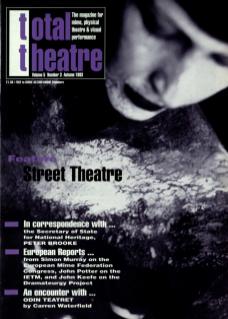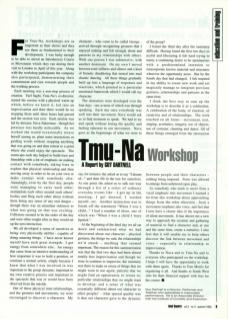For Tmu-Na, workshops are as important as their shows and they see them as fundamental to their development. I was lucky enough to be able to attend an Introductory Course in Movement which they ran during their visit to London in April of this year. Along with the workshop participants the company also participated, demonstrating their commitment and care towards people and the working process.
Each morning was a non-stop process of creation. Yael Saghi, Tmu-Na's co-director, started the session with a physical warm up which, before we knew it, led into an improvisation and then there would be no stopping them until three hours had passed and the session was over. Each session was led by director Nava Zukerman – though her presence was hardly noticeable. As we worked she would occasionally weave herself among us, plant some instructions or guiding words without stopping anything that was going on, and then retreat to a point where she could enjoy the spectacle. The warm-ups each day helped to build trust and friendship with a lot of emphasis on making contact with somebody, taking time to explore that physical relationship, and then moving away in order to be on your own or make contact with somebody else. Amazingly, even by the first day, people were managing to carry each other, manipulate each other around each other’s bodies, and fling each other about without there being any sense of any real danger, though there was an attendant riskiness to what was going on that was exciting. Collisions seemed to be the order of the day and were often sought after as they would set up the next interaction.
We all developed a sense of ourselves as being very physically skilful – capable of doing amazing things. I have never known myself have such great strength. I got energy from somewhere else. An energy that came from an intuitive understanding of how important it was to hold a position, or continue a mutual action, simply because I knew that what I was involved in was important to the group dynamic, important to my own creative process, and important in the spectacle that was or would have been observed from the outside.
Out of these physical interrelationships, and the gestures and movements, we were encouraged to discover a character. My character – who came to be called George – arrived through recognising gestures that I enjoyed making and felt strongly about and patterns in my relationships with others. With one person I was submissive, with another dominant. On my own I moved between total stillness and silence and a kind of frenetic shuddering that turned into mad chaotic dancing. All these things gradually built up into a language of responses and reactions, which pointed to a particular emotional framework which I would call my character.
The characters were developed over the four days – one avenue for this was through speaking. Each day, once everybody was well into their movement, Nava would ask us to find moments to speak. We had to try and speak without losing the quality and feeling inherent in our movement. Nava gave us the beginnings of what we were to say, for instance she asked us to say ‘I dream of...’ and then fill in the rest for ourselves. At one point she asked us to talk our way through a list of a series of ordinary everyday events like – I got up in the morning, I got dressed, I washed myself... etc. Another instruction was to finish off the statement ‘When I was a child...’. I had a number of these, one of which was: ‘When I was a child I wore lipstick.’
At the beginning of the third day we all sat down and summarised what we had discovered about our character – physical gestures, the things we said, the relationships we'd struck – anything that seemed important. The reason for this summarisation was that the first two days had been almost totally free improvisation, and though we were to continue to improvise, the summary was there to make us aware of things that we might want to use again: patterns that we might find an opportunity to return to, particular relationships that we might want to develop, and a sense of what was essentially different about our character to other people’s – what special quality was it that our character gave to the dynamic of the group?
I found the third day after the summary difficult. Having found the first two days so joyful and liberating it felt hard trying to marry a continuing desire to be spontaneous with a predetermined intention to reincorporate known material and structures wherever the opportunity arose. But by the fourth day that had changed. I felt inspired in my ability to create new work and yet magically to manage to integrate previous gestures, relationships and patterns at the same time.
I think the best way to sum up the workshop is to describe it as a celebration. A celebration of the body, of emotion, of creativity, and of relationships. The work touched on all forms – movement, text, singing, acrobatics, imagery, use of objects, use of costume, chanting and dance. All of these things emerged from the interaction between people and their characters – nothing being imposed. Form was allowed to emerge from unfettered open play.
As somebody who tends to move from a vocal emphasis into movement I learned a lot from this workshop about approaching things from the other direction – from a movement emphasis into voice – and feel that I now have a clearer idea of the importance of silent movement. It has shown me a new way to approach the creation and gathering of material to find a character and, at one and the same time, create a narrative. I also feel that it will enable me to help others discover the link between movement and voice – especially in relationship to improvisation.
Thanks to Nava and to Tmu-Na, and to everyone who participated in the workshop. I hope I will have the opportunity to work with them again. Thanks to Tom Morris for organising it all. And thanks to South West Arts for their financial support with fees for the course.
Guy Dartnell is a Director, Performer and Teacher who specialises in improvised performance. He is an Associate Director with the Institute of Curiosity and Execution

